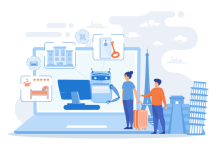
As the next decade is upon us, we should all take a minute to understand the big trends that are going to impact our contact centers.
Do you have anxiety about the bots? More broadly, are you thinking about how technology will impact how business is conducted in the contact center?
Don’t worry about the bots. Yes, they will change the way things are done, but primarily, we will combine what bots are good at with what humans are good at, and produce better customer journeys as a result.
The bots will put pressure on us, but mostly to do what humans have always been very good at: change. Our jobs are changing faster than ever before, and the bots will help, not harm, how our contact centers run over the long term. Let’s find out how.
First: It’s about Microskills
First, you see, the bots are, in fact, coming for our jobs. But not in the way you think. They’re not coming for our whole jobs; they’re coming for the part of our jobs that are the most repeatable and predictable. The bots can do repeated, predictable tasks way better than humans can. That’s why, today, most companies use chatbots to handle simple customer use cases and leave the harder stuff for the humans. Expect that to continue. (Note: Another way to think about this is that bots are good at answers, but humans are much better at questions.)
So, automation is inherently creating more microskills that humans must learn and apply (if the microskills already exist) or create new ones if they don’t. As these microskills proliferate, that will actually create more opportunities for humans to do the work that bots can’t, or that aren’t repeatable enough to warrant an investment to create a bot that can do it.
It’s conceivable that this investment will drop to the point that we’ll have a bot for the smallest repeatable tasks, but we’re a ways off. Therefore, this is actually why the contact center and outsourcing business continues to grow, nor will it decline as a result of the bots.
That’s why microskilling is so important in workforce development, especially when limited budgets mean that we have a short amount of time to teach someone to be ready for a particular job. Basically, a human can acquire a small skill much faster than a bot can. Humans are more adaptable and can infer better, and this is the key. Microskills are the new future of training.
Infer, Adapt, Combine
What makes us uniquely human is that we’re inferential thinkers—that’s what our brains are the best at: making connections between things that don’t seem connected. This enables us to do specialized work. It’s the old adage of being able to deal with whatever comes at you. Adaptability… humans are good at that because of our power of making inferences, conclusions or decisions, especially given the limited information.
You may not realize it, but in the course of your day, you’re applying hundreds of microskills that help you do whatever it is you must do. You may think you are managers, but in reality, you’re communicators, logicians, councilors, device operators, coaches, typists, analysts, etc. And you have to apply all of these skills and many more, hundreds of times a day, in the right combination and sequence, to get something accomplished.
Think about that for just a second: hundreds of skills, every day, in a combination and sequence that you choose depending on the task at hand.
Contrast that with what bots do today: specific sequences of tasks in planned (or at least predictable) combinations.
When I think about that, I have much more faith that humans will survive and thrive with the assistance of the bots, not as replacement victims of their superior capabilities but as the bots’ progenitors.
Is Credentialing Dead?
We are a skills-based employer. This means that we never look at the educational credentials someone brings into our call centers when making a hiring decision. You may think that makes no sense, especially considering the strong correlation between education and income, and education and employment.
At Fair Trade Outsourcing, we simply assess every person, regardless of their background, for the skills we know our clients will need in the particular job we’ll be putting them into. Typing, computer operation, speech, working memory, etc. … reach the minimum level of skills for that job, and boom—you’ve got it. No questions asked.
The reason we can be a skills-based employer is that we no longer care about what a particular credential says about what skills a person possesses. Similarly, we have come to mostly ignore prior experience. Why is that?
As much as you can, I encourage you to stop thinking about training and your workforce development monolithically. Jobs are no longer monolithic; they’re as dynamic as we’ve ever seen them in the history of human work, and they will continue to become more dynamic. Pardon the cliché, but we all must become lifelong learners.
And that extends into the way you train, staff and manage your contact center. If jobs are ever-changing, and now changing so much faster, why would a credential earned 10 years ago be proof that a particular person has all of the microskills you need for them to accomplish that one job? The answer: It doesn’t, and it shouldn’t be expected to.
The Answer: Microskills, Technology and Change
As new work comes into your contact center or delivery center, how are you evaluating and compiling the team that’s doing that work? If you’re already working with agent assistive technology, or thinking of deploying new technology, how are you dividing the labor and technology you have to create the optimum customer journey?
The process I just described is more akin to how software is developed. Think “use cases” instead of customer journey. The reality is that when technology and labor (with the right microskills) combine to render a customer journey, what we’re really doing is thinking about the “user experience” in the same way you do in the software development process.
Except that we’re now thinking about two sets of users: our customers and their journey, and the agents and the experience they’re going to have using technology to advance the customer journey. This may seem more complex, and it is to a certain extent, but the reality is that you’re already thinking this way. Don’t we often have meetings with the software teams to tell them how internal tools aren’t optimally serving the agent? It’s the same process.
But with better results. Not only is the customer journey enhanced, but the agent has a better overall experience, as well. When assistive technology is deployed to help both the customer and the agent, the agent will feel better with less obstacles to doing their work, and as a result, frustration will drop and agent engagement will improve.
Bots, skills, change: These are important and very interesting questions as we look forward into the next 10 years of the contact center. We all know the landscape of work is changing and we all have to be thinking about how it affects us currently and far into the future. Use this small roadmap I’ve given you to start thinking about how it will change the work you’re currently doing, and most importantly, as a new way of looking at the training of your agents.
Going into the next decade, our value as humans will be about how apply the microskills we possess and the ones we can learn to create value with our bot partners for customers along their journey. I don’t know about you, but that sounds like it’s going to be fun!




